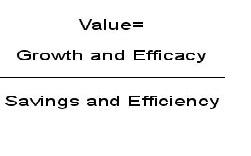The Value Equation for Customer-Centric Innovation
IT leaders need to understand what it means to be innovative and what the boardroom expects from them. While the word is greatly overused, understanding the basic tenets of innovation and anticipating user experience is essential to integrating new technologies and delivering value to customers.
Some view true innovation as disruptive to the current market, focusing on shiny objects and referring to new products, particularly technology and electronics. What is missing is the powerful impact on processes and the business model. An altered business model (often facilitated While many equate it to an invention, innovation is the process of implementing new ideas that create value. To understand innovation, consider two aspects: categories and phases.
Categories. The recommended five categories are process innovation, marketing innovation, business model innovation, management innovation, and of course, products and services. This practical and memorable categorization moves away from thinking innovation is primarily about new electronics and gadgets, as there are more areas to innovate in than most initially consider.
Phase. The phase refers to where the idea falls on the product lifecycle. Significant innovations are called disruptive innovation and debut in an initial phase as a new product, service, management approach, process or business model that fundamentally changes the way we fulfill wants and needs.
The next phase is incremental innovation. Once a disruptive innovation begins to be adopted, there are typically incremental improvements made to it that usually continue through its lifecycle. This is where most innovation efforts occur, albeit at a smaller scale and more frequently.
The power of incremental innovation in aggregate can be as competitively differentiating as disruptive innovation. Organizations focused on quality and speed, gaining improvements and shortening cycle times wherever possible are those that typically win in the marketplace. Even then, organizations have to seek to disrupt themselves.
[Learn more about finding value in a digital transformation.]
It should not come as a surprise that many have trouble understanding the word innovation and its use, as 94 percent of global executives are dissatisfied with their company’s innovation performance. Organizations frequently have trouble discussing innovation, much less really understanding the customer experience, and for many, this comes late in the process.
Understanding customer experience is essential
Technology has removed much of the friction that previously made it difficult to start a competitive business. Organizations now must immerse themselves in their customer’s world, understand the nuance of their experiences, anticipate future needs and constantly challenge existing business models and value propositions. Doing so allows companies to mitigate some competitive threats and deliver value.
The strategic foresight that goes into customer experience in the boardroom should be echoed in the IT department. Companies should monitor how customers engage and create insight that allows for customer-centric innovation. Yet the majority fail to measure the journey across channels. Dissatisfied customers are four times more likely to take their business to a competitor.
Customers often report being willing to pay for a better experience, which is why they should be the focal point for innovation. Peter Drucker said in The Practice of Management, “The purpose of a business is to create a customer.” A company ignoring customer experience is destined to fail. The lifeblood of any organization is the customer and becoming more effective in delivering value is today’s IT challenge, and it is time for IT to lead.
To drive customer-centric innovation focus on the value equation
Value can be expressed as an equation:
Value increases when the denominator decreases or when the numerator increases. For too long IT has been predominantly denominator focused, driving out costs

Today, the CIO’s expectations are raised, and For example, machine learning provides the ability to learn tasks without the need to program a specific function or routine. For organizations focused on improving customer experience, it helps detect customer use and engagement patterns, both in operations and interactions. This allows businesses to identify relevant insight and deliver new value. It also simplifies engagement, reduces manual intervention, and automates routine tasks, which improve performance and customer experience.
Overall, the value equation for customer-centric innovation comes down to shifting the focus from cost savings to revenue growth and a competitive differentiation. This type of innovation is a deep learning on how to transform complete business models, not just technology. But it starts with the customer in mind and incorporates them throughout the process, creating and elevating a new customer experience.

Doug Reeder is in the Office of the CTO at NTT DATA Services.
